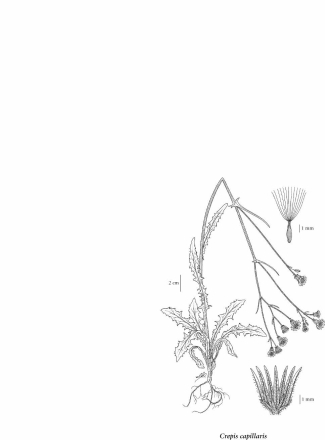Crepis capillaris (L.) Wallr.
smooth hawksbeard
Asteraceae (Aster family)
Introduction to Vascular Plants
smooth hawksbeard
Asteraceae (Aster family)
Introduction to Vascular Plants
Species Information
General:
Annual or occasionally biennial herb from a relatively short taproot; stems erect, solitary, often much branched, short-hairy near the base or throughout, 20-90 cm tall.
Leaves:
Basal leaves lanceolate or oblanceolate, 3-30 cm long, 5-45 mm wide, long- to short-stalked, toothed to pinnately cut, the lobes pointing backwards, or evenly bipinnately parted, the blade obtuse or abruptly sharp-pointed, glabrous or short-hairy beneath on the midrib with short yellow hairs, sometimes sparsely short-hairy above and often soon deciduous; lowermost stem leaves similar to the basal; middle and upper stem leaves lanceolate, abruptly sharp-pointed, unstalked, with abruptly sharp-pointed, ear-like flanges at the base.
Flowers:
Heads with strap-shaped flowers, 20-60 in a flat- or round-topped inflorescence; involucres 5-8 mm tall, cylindric to top-shaped; involucral bracts glabrous or woolly, the outer ones about 8, linear, up to 1/2 as long as the 8-16 inner ones, these woolly and often glandular-bristly with black hairs as well, glabrous within, lanceolate, abruptly sharp-pointed, becoming spongy-thickened on the back; receptacle glabrous; ray flowers yellow, 7.5-12 mm long.
Fruits:
Achenes brownish-yellow to dark brown, 1.5-2.5 mm long, spindle-shaped or oblong, abruptly narrowed at both ends, about 10-ribbed; pappus white, of fine, soft, hairlike bristles.
Illustration

If more than one illustration is available for a species (e.g., separate illustrations were provided for two subspecies) then links to the separate images will be provided below. Note that individual subspecies or varietal illustrations are not always available.
Illustration Source: The Illustrated Flora of British Columbia
Ecology
Ecological Framework for Crepis capillaris
The table below shows the species-specific information calculated from
original data (BEC database) provided by the BC Ministry of Forests and Range.
(Updated August, 2013)
The table below shows the species-specific information calculated from
original data (BEC database) provided by the BC Ministry of Forests and Range.
(Updated August, 2013)
| Site Information |
Value / Class |
||
|
Avg |
Min |
Max |
|
| Elevation
(metres) |
285 | 171 | 1370 |
| Slope
Gradient (%) |
10 | 0 | 45 |
|
Aspect (degrees) |
220 | 45 | 337 |
| Soil
Moisture Regime (SMR) [0 - very xeric; 4 - mesic; 8 - hydric] |
3 | 3 | 3 |
| Modal
Nutrient Regime
Class |
D | ||
| #
of field plots species was recorded in: |
62 | ||
| Modal
BEC Zone Class |
CWH | ||
|
All BEC Zones (# of stations/zone) species was recorded in |
CWH(61), IDF(1) | ||
|
Source:
Klinkenberg 2013
|
|||